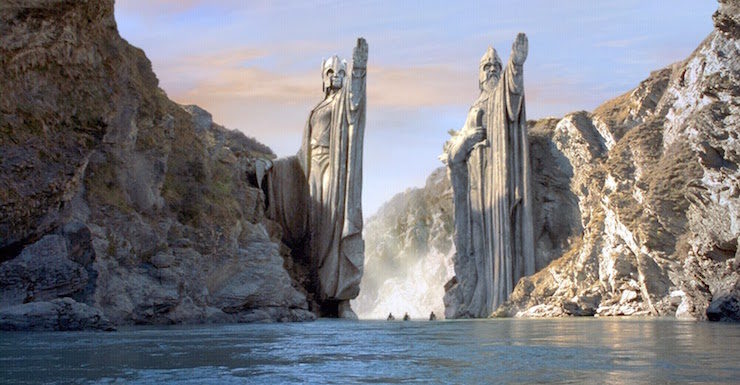Remember when I said that the map of Middle-earth had 99 problems and mountains were 98 of them? Well, it’s time to talk about that one remaining problem: rivers. I’ll mostly be talking about the Anduin here, since it’s the most major river on the map.
But first: why do I keep coming back to Tolkien? There are a few reasons. Just as Tolkien’s novels have had a massive influence on epic fantasy as a genre, his map is the bad fantasy map that launched a thousand bad fantasy maps—many of which lack even his mythological fig leaf to explain the really eyebrow-raising geography. The things that make me cringe about the geography of Middle-earth are still echoing in the ways we imagine and construct fantasy worlds today.
But also, perhaps more importantly, Tolkien is no longer with us. He’s far beyond caring that I don’t like his invented geography even if I do like his books. I’d much rather use him as an example than pick on the map of someone who is alive and able to feel attacked by my loving annoyance at the placement of their fjords.
Or the incomprehensible courses of their rivers—or rather, the oddities of the drainage basins that feed the rivers. When you’ve studied sedimentary geological processes for any length of time, the idea of your basin—the not-really bowl-shaped-except-in-the-most-general-sense area that is a low surrounded by highs from which water drains and carries its sediment load—is all-important. Rivers are created and fed water and sediment by their drainage basins, and have their own lives that develop over time.
To quote Anderson and Anderson in their seminal textbook Geomorphology: The Mechanics and Chemistry of Landscapes:
…Because water flows through landscapes, it is a great integrator. It is for this reason that most geomorphologists view the drainage basin, the total area that contributes runoff to a given cross section of a river, as a fundamental unit of landscapes… This method of parsing up landscapes is so common that areas lacking regularly branching rivers and well-defined divides (sensible drainage basins) are considered “deranged.” (349)
So what is it about the mighty Anduin that makes me tilt my head like a dog hearing a high-pitched noise? There are four main factors, in ascending order based on how easily I’m able to mentally excuse each point.
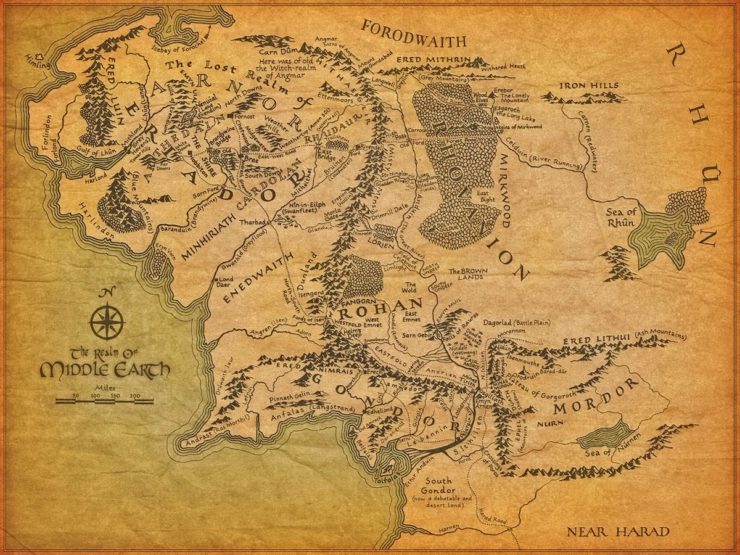
It cuts across two mountain ranges.
There is one fact you really need to understand to grasp the basics of how rivers work. Ready? Water flows downhill. That’s it. That’s the secret. Water flows downhill, and as it flows it tends to erode sediment and transport it downstream, and over long enough periods of time, that gets us our classic V-shaped river valleys and a ton of other morphological features. Which is why, when a river is on a collision course with mountains—normally places where the elevation goes up—you have to stare at it for a minute.
This is the easiest oddity for me to find an excuse for—because it is actually something that happens in reality! For example, the Colorado River cuts pretty much perpendicularly through the entire Basin and Range Province of North America. And the reason this works is because the Colorado was here before all that extensional tectonic silliness happened and the basins started dropping down from the ranges—and that process of down-drop was slow enough, relative to the ability of the Colorado to cut its own channel, that the river didn’t get permanently trapped in one of the basins.
So if we make the assumption that the Anduin existed before the mountains—and assume that the mountains uplifted in a natural way, thank you—it’s very possible for it to have cut down fast enough to maintain its course despite uplift. (Keep this in mind, we’ll be coming back to it later…)
Where are the tributaries?
Rivers usually have a dendritic network, which looks sort of a tree in reverse made of flowing water. “First order” streams make the thinnest tips of the network, like the twigs at the very end of branches. The first order streams combine into second order streams, which combine into third order streams, and so on. Stream networks are generally fractal (this is the number one way to artificially generate a realistic-looking drainage pattern), though it should be noted that the fractal nature breaks down when you get to the channel origins of the first-order streams.
It’s very unusual for a large river to split before it reaches baselevel—defined here as the elevation at which a river reaches a relatively still body of water and effectively stops. Baselevel is generally going to be sea level, unless the river is trapped in a local basin. Anyway, at baselevel, rivers tend to fan out into a delta, because they hit a point where the slope is effectively zero and they no longer have the energy necessary to carry their remaining sediment load. This makes little things like the apparent delta of the Entwash where it connects to the Anduin seem really weird, from a geological standpoint, because somehow that stream’s hit its baselevel, but the Anduin continues blithely flowing onward—so obviously there’s some kind of slope going on there. That connection can’t be the Entwash suddenly turning into a braided river either, for similar reasons—the Anduin is still just doing its thing.
Some of this, I can mentally excuse because at some point it becomes a question of map resolution. Most maps, depending on the scale, are only going to show the really high-order streams. So it could just be that a lot of the tributaries are below the resolution of the map.
However, there’s another oddity that leaps out, particularly in relation to the Anduin: it looks like a tree missing half its branches. There are several tributary streams that we see coming off the Misty Mountains to the west… and nothing from the east. This gives the impression that the river isn’t really the lowest available point of its own drainage, or that there’s something really off about the apparent basin that seems to run from the Misty Mountains to the Sea of Rhûn.
What exactly is the Anduin’s drainage basin, anyway?
“Lakes are local drainage problems,” is a geomorphologist joke that is absolutely hilarious if you spend most of your time modeling sediment transport. But what lakes (or little seas, like the Sea of Rhûn and the Sea of Núrnen in Middle-earth) represent is a local baselevel. They indicate the fact that, due to local topography, the drainage has no way of leaving the basin and making it to the ocean… so the water has its own party (in the form of a lake or sea) that’s totally as good as the one going on in the ocean—just smaller.
In light of this information, the Sea of Núrnen actually makes geographical sense because it’s surrounded on three sides by mountain ranges and I’m going to pretend that to the east, just off the map, there’s some other elevated feature that prevents all fluvial escape. So the Sea of Núrnen presumably occupies the lowest available area in the basin and that’s why all the rivers head straight for it.
But then, what is the deal with the Anduin? There’s nothing to indicate some division between its side of the basin and that which is occupied by the Sea of Rhûn, other than that little patch of unnamed mountains to the sea’s west, and the Mountains of Mirkwood, which are a tiny, east-west range. Why do the Carnen and the Celduin bear east instead of joining up with the Anduin? Why does the Forest River, which originates in spitting distance of the Greylin, make a beeline through Mirkwood toward the Celduin instead of joining with the Anduin? Is there an invisible mountain on the western edge of Mirkwood? Did the Forest River and the Anduin have some kind of nasty fight and they’re just not speaking to each other anymore? And what’s the topographic deal with the Brown Lands? As it looks right now, you’ve got a big basin with two completely distinct north-south drainage systems, which is… weird. Really weird.
Now, if there was some kind of topographic high between the two river systems—and there’d be drainage shedding from both sides of that, by the way—that would go a long way to explaining the final issue as well. Which is…
What is with the Anduin’s course?
For much of its run, the Anduin is roughly parallel to the Misty Mountains—it doesn’t really deviate until Lorien, and even then it stays pretty close considering the apparently massive, empty area to its east. This is an odd-looking feature I have seen in many a fantasy map.
So why is it odd? Remember what we covered in point number one? Water flows downhill. And beyond that, it tends to follow the steepest gradient downhill, thanks to gravity. To illustrate what I mean, let’s take a look at a contour map.
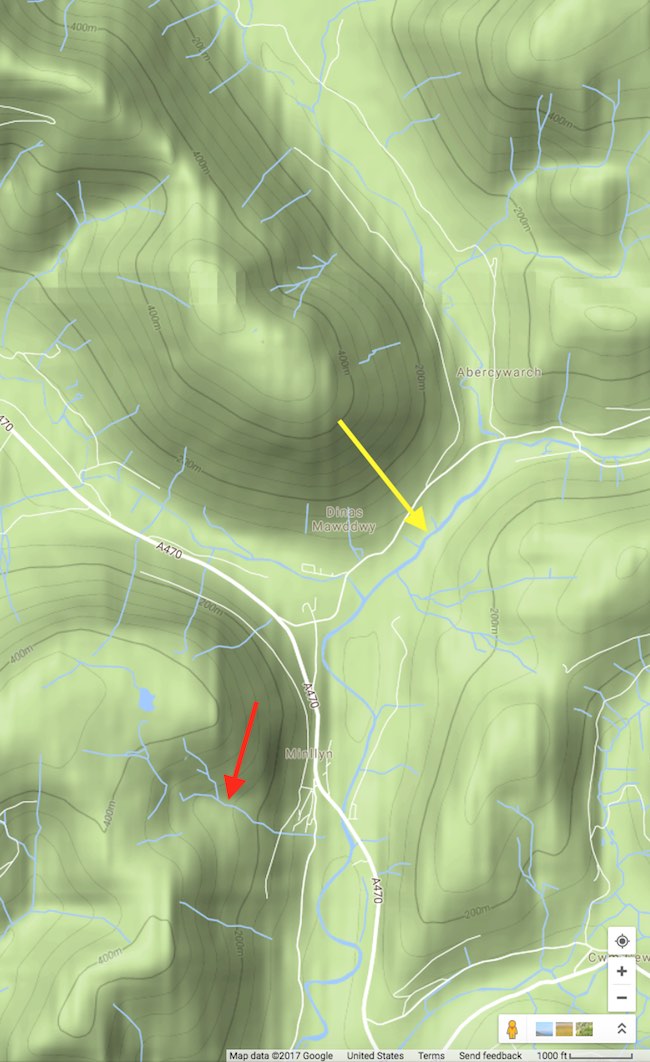
Map courtesy of Google Maps. You’ll note that this is a fairly small area we’re looking at (scale in lower right corner) and it’s got about 400m of relief. But what holds true for streams at a smaller scale is going to hold generally true for larger streams. What I want you to note is that the first and second order streams—the tributaries, example marked in red—tend to cut across the elevation contours, nearly perpendicularly. They’re taking the shortest path down the elevation. (You’ll even note that for some of them, the contours point inward toward the stream; this is an erosional feature, meaning the stream has cut into the landscape and made a valley.) The highest order stream is marked in yellow—it’s sitting in the lowest elevation, but still draining downhill. You’ll note that this means it’s going along the foot of the hills…because there’s a hill on the other side of it. It’s effectively trapped in this corridor, which in reality is probably the valley that it’s cut for itself over tens of thousands of years.
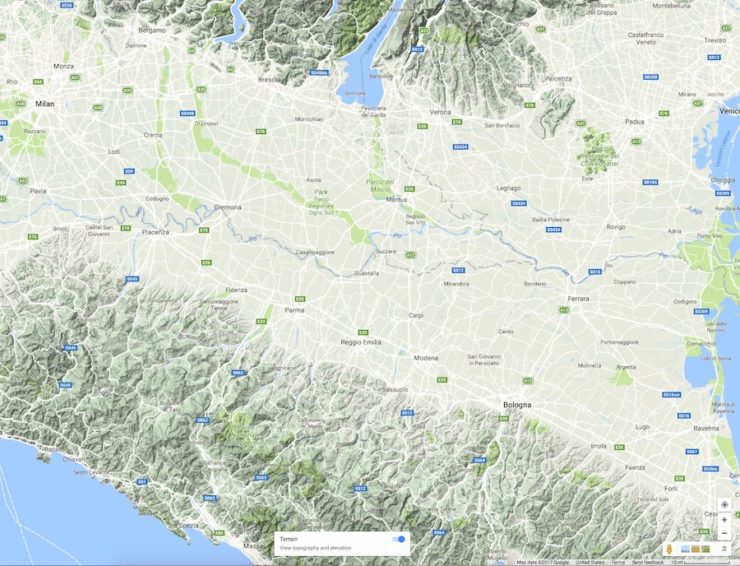
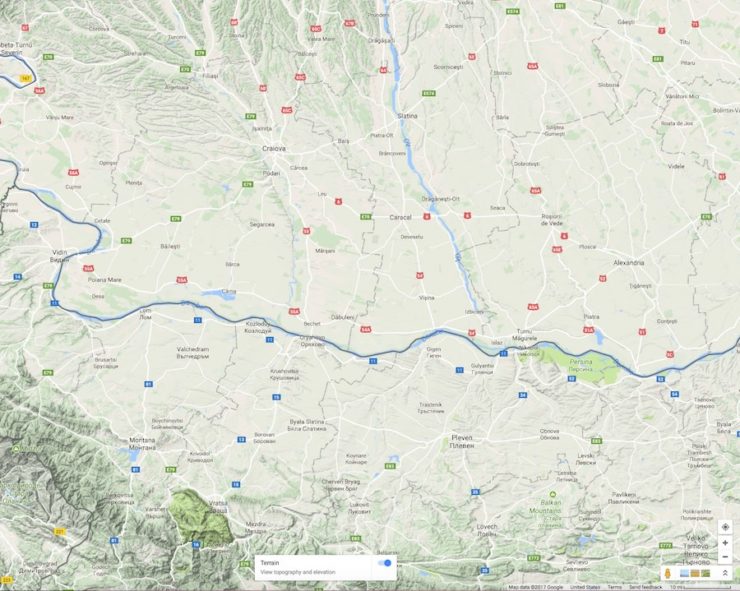
You can find big rivers that do appear to run roughly parallel to high relief areas. Such as this section of the Po (top) and Danube (bottom). But the other thing I want you to note is that these rivers have a high relief area on either side of them, relatively close. We’re basically looking at a wide flood plain between two topographic highs. When it’s a situation where you’ve got mountains on one side and a big flat basin on the other, like we see with, say, rivers of the Amazon Basin…
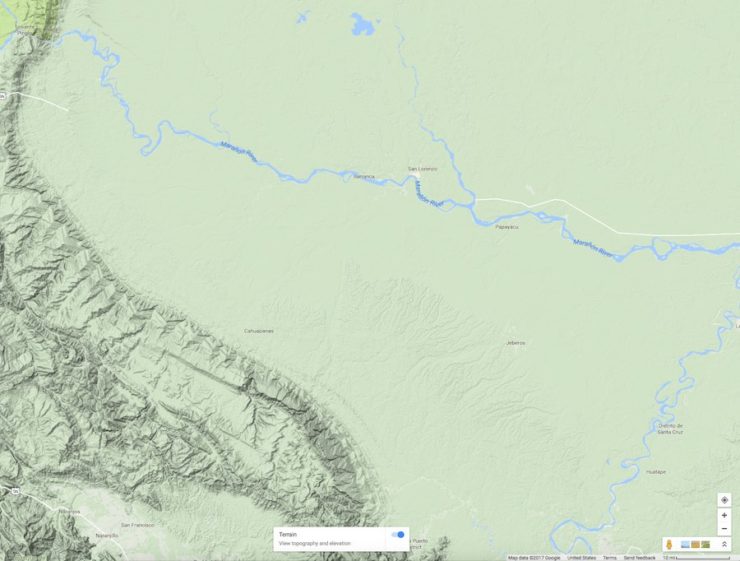
The river just can’t get the hell away from the mountains fast enough.
Rivers want to go out to the baselevel—the lowest point—of their drainage basin. They’ll meander once their gradient gets low enough, for certain. But so long as there’s a downhill slope to be found, they’ll be heading down until they’re as low as they can get. So with no area of higher elevation to the east of the Misty Mountains, by all rights the landscape should be gently sloping downward in that direction—and the river should be following it.
It’s the strange drainage basin issues that ultimately cause me to run out of excuses for the rivers of Middle-earth. Even if you grant the mountains as things created by the Valar doing their Valar-thing—which means my mental excuse for the Anduin cutting through mountain ranges is void—it still looks weird from a geological perspective.
Because unless all of that happened an extremely short time ago (as in less than a couple hundred years), the river would have started to change its course in response to the elevation differentials we see. Rivers are not static things. Water flows downhill, remember? And while it’s running downhill for all its worth, water erodes sediment from one place and dumps it in another. Rivers are constantly cutting and re-cutting new courses for themselves, building new channel levees and bursting through them. Though I suppose one could always argue that water in Middle-earth works differently than it does on Regular Earth, and geomorphology is an invention of Sauron.
Alex Acks is a writer, geologist, Twitter fiend, and dapper AF. Their sweary biker space witch debut novel, Hunger Makes the Wolf, is out now from Angry Robot Books.










